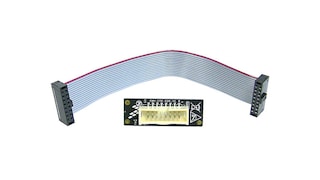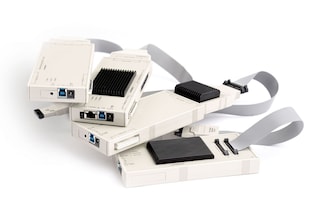
PowerQUICC® II Pro Processor with DDR2, Dual PCI, 1 GB Ethernet, Dual USB, Security
Sign in for a personalized NXP experience.
Our MPC8360E PowerQUICC® II Pro family of integrated communications processors is a next-generation extension of the popular PowerQUICC II line containing cores built on Power Architecture® technology. The MPC8360E family incorporates a next-generation communications engine, the QUICC Engine®. supporting a wide range of protocols, including Gigabit Ethernet (GbE) and OC-12 asynchronous transfer mode (ATM)/packet over SONET (POS). Additional enhancements include the e300 core (enhanced version of the 603e™ core with larger caches), scaling up to 667 MHz, a double data rate (DDR) memory controller and the integrated security engine.
The MPC8360E PowerQUICC II Pro communications processor's advanced features make it suitable for today and tomorrow's wired and wireless access equipment, as well as small and medium enterprise networking equipment. Target applications include multitenant units (MTUs), DSL access multiplexers (DSLAMs), wireless basestations, multi-and fixed-subscriber access nodes, add/drop multiplexers and routers.
The MPC8358E processor, a member of the MPC8360E PowerQUICC II Pro family, is pin-compatible with the MPC8360E. The MPC8358E offers a cost-effective, low-power processing solution that meets the performance requirements for broadband access applications, such as small-to-medium enterprise (SME) routers, low-end DSLAMs and IP private automatic branch exchange (PABX) systems.
e300 System-on-Chip Platform
The MPC8360E PowerQUICC II Pro family is based on the e300 system-on-chip (SoC) platform. This makes it easy and fast to add or remove functional blocks and develop additional SoC-based family members for emerging markets. At the heart of the e300 SoC platform is Our e300 core built on Power Architecture technology. The e300 core is an enhanced version of the 603e core used in previous-generation PowerQUICC II processors.
Enhancements include twice as much L1 cache (32 KB data cache and 32 KB instruction cache) with integrated parity checking and other performance-enhancing features. The e300 core is software-compatible with existing 603e core-based products.
Connectivity
The MPC8360E processor is designed to support a wide range of communications interfaces, such as MII, RMII, GMII, TBI, RTBI, NMSI, UTOPIA, POS and TDM. The dual 32-bit DDR memory controllers help to ensure high-speed memory access and a local system bus operating up to 133 MHz. Additional system connectivity is supplied by dual UART, dual inter-integrated circuit (I²C), dual serial peripheral interface (SPI), PCI interfaces and universal serial bus (USB) interface (USB 2.0 full-/low-speed compatible).
Integrated Security
The MPC8360E and MPC8358E processors feature integrated security with the powerful integrated security engine derived from Our security coprocessor product line. Integrated security supports DES, 3DES, MD-5, SHA-1, AES and ARC-4 encryption algorithms, as well as a public key accelerator and an on-chip random number generator. The integrated security engine is capable of single-pass encryption and authentication, as required by IPsec, the IEEE® 802.11i standard and other security protocols.
Typical Applications |
|
DSL infrastructure
|
Add/drop multiplexers and digital cross connects Multiservice access nodes (MSAN) |
Wireless infrastructure
|
Small and medium enterprise (SME) routers
|
| Integrated voice routers and digital IP-based private automatic branch exchange (PABX) | |

Note: To see the product features close this window.
| | | | | |
|---|---|---|---|---|---|
| | | | | |
| | | | | |
| | | | | |
| | | | | |
| | | | | |
| | | | | |
| | | | | |
| | | | | |
| | | | | |
| | | | | |
MPC8360EQuick reference to our documentation types.
1-10 of 65 documents
Compact List
There are no results for this selection.
Please wait while your secure files are loading.
1-10 of 65 documents
Compact List
1 design file
Please wait while your secure files are loading.
1 design file
3 hardware offerings



2 hardware offerings


To find additional partner offerings that support this product, visit our Partner Marketplace.
3 hardware offerings



Quick reference to our software types.
1-5 of 6 software files
Additional software available. View our featured partner solutions.
Note: For better experience, software downloads are recommended on desktop.
Please wait while your secure files are loading.
1-5 of 18 software offerings
To find additional partner offerings that support this product, visit our Partner Marketplace.
1-5 of 6 software files
Additional software available. View our featured partner solutions.
Note: For better experience, software downloads are recommended on desktop.
1-5 of 6 engineering services






There are no results for this selection.
There are no results for this selection.
To find additional partner offerings that support this product, visit our Partner Marketplace.
1-5 of 12 trainings
To find additional partner offerings that support this product, visit our Partner Marketplace.
1-5 of 12 trainings
To find additional partner offerings that support this product, visit our Partner Marketplace.

Help us improve your experience on our site. We invite you to take our five-question survey.